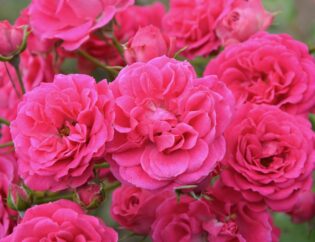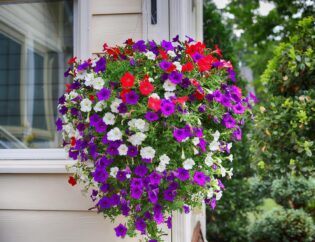
Southern gardeners love a plant that isn’t afraid of the sun. Thus, annual vincas are a popular choice in Atlanta gardens.
These sun-loving, drought-resistant plants are easy to grow and produce flowers in a wide range of colors. Let’s take a closer look!
What Are Annual Vincas?
More than one Sun Belt gardener has tried to get pansies and impatiens to grow and watched them languish in the hot sun. For those gardeners, annual vincas have come to save the day.
Vinca flowers look very similar to impatiens, producing a five-petal flower that touches or overlaps with dark green, glossy leaves. Through the work of horticulturists, there are a number of flower colors available from red to pink to purple, and many shades in between.
Why Are They Popular?
Gardeners love annual vincas for several reasons.
First, the fast-growing plants are relatively easy to start from seed and will grow to their 6-18 inch mature height by mid-summer. The colorful flowers enjoy a long blooming season from early summer all the way to the first frost.
Plus, the plants are extremely easy to care for. Put them in the right conditions, and they’ll grow and bloom with little intervention. Every gardener’s favorite plant!
Further, there is a perk to planting species that don’t survive the winter: variety. Unlike perennials that come back year after year, annuals are replaced each spring. Thus, annual garden beds are not set in stone: one year a flower bed, the next a tomato garden.
For avid gardeners with small backyards, an annual flower garden is an opportunity to experiment and start fresh each year. Annual beds installed alongside perennials and hardscape allow home gardeners to have the best of everything while still enjoying all the gardening hobby has to offer.
And for those who prefer to change things up? Different color palettes can be chosen on a seasonal basis to suit the homeowner’s taste.
Where Should I Plant Vincas?
Annual vincas love heat and light. They should be planted in a place where they can enjoy full sun. A little bit of afternoon shade is okay, but if the area is too shady the plant will become leggy.
Vincas are a great plant for dry areas as they are drought-resistant but do not grow well in wet conditions. In fact, homeowners who water their vincas too frequently may be baffled by their lack of flowers and yellowing leaves. (For boggy soil, consider ferns).
Use well-draining soil to ensure they don’t stay too wet.
When Should It Be Planted?
Take care not to plant annual vincas too early. They are a hot weather plant and if the temperature drops too low, they will have a hard time getting started.
Gardeners can start seeds indoors about 12 – 16 weeks before the average last frost. They should be kept at their ideal germination temperature of around 75 degrees Fahrenheit.
Plant vincas outside once the evening temperatures are averaging around 60 degrees.
How Often Should I Water?
Do not overwater annual vincas!
Wet, soggy soil will inhibit the plant’s growth and the flowers will suffer. This drought-resistant plant does not do well in wet conditions and may fall victim to stem rot, leaf spots, and root rot if left too wet.
Water only when the top inch of soil is dry to the touch. This usually means weekly watering, though if the plant gets rainfall, beware of watering too much.
What Wildlife Do They Attract?
Love watching beautiful butterflies flit about? Vincas are a perfect addition to the flower garden! Butterflies adore the bright blooms on vinca plants, and will love hanging out in a yard brimming with them.
Furthermore, vincas are resistant to most pests and diseases. They’re even resistant to those pesky rabbits that like to feed on plants in some Atlanta gardens! This is another area where vincas are a better alternative to impatiens: rabbits will happily eat impatiens but vincas are unpalatable.
Can I Plant Vincas in Containers?

Any patio design looks great with the addition of beautiful flowers and greenery. Annual vincas grow well in pots or containers as long as there is good drainage. General-purpose, well-draining potting soil is usually enough. If the soil is heavy at all, try adding perlite or pumice to promote good drainage and a loamy, aerated soil.
Some varieties of vinca can trail about 2 feet, making them great to use in hanging baskets. (Learn how to install hanging baskets here).
Do Vinca Plants Come Back?
Vincas are grown as annual plants, though it is possible for them to self-seed and come back the next year. However, because of their sensitivity to cold, they have a hard time making it through the winter.
It’s easy for gardeners to propagate them indoors, however. Simply take a few cuttings in early fall and root them in water over the winter. In late winter, place the rooted cuttings in potting soil so they will be ready to plant when the weather warms up.
Should I Deadhead Vincas?
Deadheading is not necessary. Vincas are self-cleaning and don’t require any help from the gardener — another reason why people love them!
As long as the plant is getting plenty of light and is watered appropriately, the flowers will bloom brilliantly all summer.
If a vinca plant is struggling, try applying a slow-release granular fertilizer or foliar spray. And make sure that the soil is draining well. Waterlogged roots prevent the vincas from blooming.
Are Vincas Toxic to People or Pets?
Vincas should not be planted in a place where curious pets might eat the plant. Unfortunately, vincas are toxic to people, dogs, cats, and horses.
Ingestion can cause gastrointestinal problems, low blood pressure, tremors, seizures, coma, and even death. If ingestion is a concern, consider non-toxic annuals like petunias, zinnias, and snapdragons.
The Best Vincas
While all vincas sport bright, cheerful blooms, there are a few special ones that stand out from the crowd.
- Stardust Orchid Series: Striking and unique, has a white star-shaped center with colorful edge
- Heatwave Series: Compact variety with outstanding heat tolerance
- Mediterranean Series: Trailing type well-suited to hanging baskets
Are Annual Vincas the Same Thing as Vinca Minor?
Annual vincas are sometimes confused with vinca minor, also known as common periwinkle. However, they are not the same thing.
Annual vincas grow upright and have pink, purple, or red flowers. Vinca minor is a low-growing ground cover plant with pale purple flowers and dark leaves.
Got a Project in Mind?
Here at Atlanta Turf & Tree, we take immense pride in building beautiful, lasting landscapes that double as living art. We have over 35 years of combined experience in the industry and understand the challenges unique to Georgia landscapes. Contact our landscaping services experts to get going on your project!










